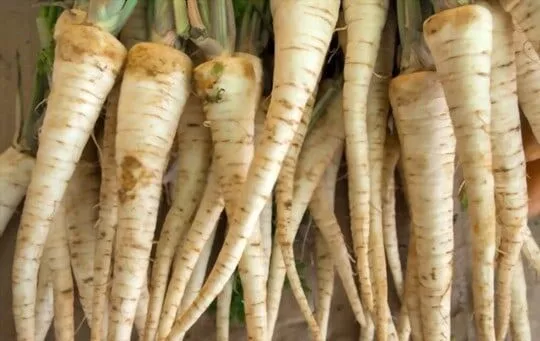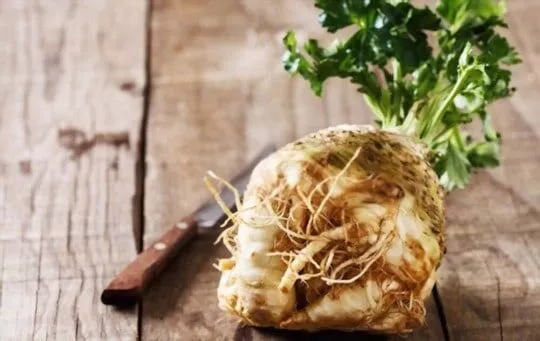Roasted, mashed, or pureed, parsnips are a delicious winter vegetable.
The sweet flavor of parsnips is an ideal accompaniment for many dishes such as roast dinners or casseroles.
But what can you use if you find your grocery store shelves are empty?
What are the best alternatives for parsnips? Parsnips can be substituted with other root vegetables like turnips, rutabagas, potatoes, and carrots. These vegetables have a similar taste and texture to parsnips, making them perfect substitutes in most recipes. If you want more of a nutty flavor in your dish without the texture of a root vegetable, try using almond meal instead.
With these 10 best substitutes for parsnips at hand, you can still make all your favorite dishes without missing out on the unique sweetness of this special vegetable!
Let’s explore which ingredients work best to give your meals the perfect flavor when parsnips are not available.
What Are Parsnips?

Parsnips are a root vegetable that belongs to the same family as carrots and parsley.
They have a sweet, nutty flavor and a starchy texture, and are often used in soups, stews, and roasted dishes.
Parsnips are a versatile and nutritious vegetable that can be enjoyed in a variety of dishes.
They are a good source of fiber, vitamin C, and potassium, and can be cooked in a number of ways to bring out their unique flavor and texture.
Whether roasted, boiled, mashed, or used in soups and stews, parsnips are a delicious and healthy addition to any meal.
[TABLE]
The 10 Best Substitutes for Parsnips
If you’re looking for a vegetable that has a similar flavor profile to parsnips, you’ll be pleased to know that there are plenty of great substitutes.
Here are ten alternatives you can use in place of parsnips for all your cooking needs:
1 – White Carrots

White carrots have the same earthy flavor as parsnips but slightly less sweetness.
They also have a slightly crunchier texture and more water content than regular carrots, making them great for adding moisture to salads, stews, and curries.
White carrots can be roasted, boiled, or steamed just like their yellow counterparts and make an excellent addition to any dish.
2 – Orange Carrots

Orange carrots offer a mild sweetness with an earthy undertone that’s reminiscent of parsnips.
They yield better flavor when cooked rather than eaten raw and pair wonderfully with spices and herbs like cumin, coriander, thyme, and bay leaf.
Baked orange carrots create tenderness while maintaining the root vegetable’s unique taste.
3 – Turnips

Turnips are related to parsnips in both family tree and flavor profile.
While turnips tend to be milder in taste than their white-fleshed counterpart, they can still replicate the desired flavors when cooked properly.
Roasting turnip chunks brings out its natural sweetness while adding depth of flavor; this is perfect for soups, stews, or even as a side dish all on its own!
4 – Celeriac (celery root)

This lesser-known root vegetable is related to celery but tastes nothing like it!
Celeriac has an earthy yet nutty flavor similar to that of parsnips.
It can easily be mashed into a creamy texture or diced and roasted in oil for a flavorful accompaniment to any main course meal.
5 – Kohlrabi

Kohlrabi is another relative of the cabbage family whose white flesh holds sweet notes with hints of peppery bite – reminiscent of its cousin parsnip!
When baked or boiled until soft yet firm, kohlrabi takes on a delicate texture that works well when served alongside roasted meats or lightly sautéed vegetables.
Its versatility allows it to fit seamlessly into many dishes with ease!
6 – Salsify

Salsify is a root vegetable similar in appearance to parsnips.
Though not as widely known or utilized, salsify has an earthy taste and crunchy texture perfect for creamy soups or side dishes.
It’s also an excellent source of Vitamin C and dietary fiber, making it a great addition to any meal.
To substitute salsify for parsnips, simply peel and cube them before boiling or baking in oil like you would with parsnips.
By opting for salsify instead of parsnips you’ll experience its unique flavor profile while boosting your nutritional intake.
7 – Arracacha
Arracacha is another underrated root vegetable related to the carrot family.
It has a unique taste between celery root and potatoes with hints of sweetness reminiscent of parsley and chestnuts.
Not only does it have an interesting flavor but it is also packed with essential vitamins like Vitamin A, Vitamin B6, and Vitamin K.
When using arracacha as an alternative to parsnips, you can prepare it the same way; simply rinse off any dirt, peel away the outer layers then cube it before boiling or baking them in oil with other ingredients.
8 – Sweet Potato

Sweet potatoes are often confused for yams due to their similar coloration but they offer their own unique benefits too!
They contain high levels of antioxidants which are beneficial for reducing inflammation as well as significant amounts of potassium which helps improve blood pressure levels.
To enjoy sweet potatoes as a substitute for parsnips boil or bake them just like you would with regular potatoes until they reach desired tenderness then mash them together with other ingredients like butter or milk.
9 – Potato

Potatoes have long been enjoyed worldwide due to their versatility – they can be boiled, mashed, fried, baked – whatever suits your needs!
Potatoes contain vitamin C which helps boost your immunity against colds and cases of flu but also high levels of carbohydrates which provide energy throughout the day.
When substituting potatoes for parsnips make sure to cut them into small cubes so they cook evenly then roast or fry until they reach desired crispiness before adding other ingredients such as butter or herbs.
10 – Parsley

Parsley may not be considered a traditional substitute for parsnips but this herb actually pairs well with other vegetables when used correctly!
Its distinctive aroma adds depth when incorporated into soups and stews making it ideal for adding extra flavor without overpowering the dish itself.
Parsley contains many essential vitamins including vitamin A which helps improve vision health and iron which is essential for proper red blood cell formation in our bodies – so don’t discount this herb from your next recipe!
To use it as an alternative simply add it towards the end of cooking time so its freshness is retained throughout the dish resulting in flavorful meals every time!
Frequently Asked Questions (FAQs)
What vegetable is like parsnip?
White carrots are the most similar vegetable to parsnips, both in appearance and flavor. However, other root vegetables like turnips, celeriac, and kohlrabi can also be used as substitutes.
Can you use carrots instead of parsnips?
Yes, carrots can be used as a substitute for parsnips in most recipes, although they have a slightly different flavor and texture. Carrots are sweeter and less starchy than parsnips, but they can still be used in soups, stews, and roasted dishes.
Are parsnips like parsley?
Parsnips and parsley are both members of the same plant family, but they are not very similar in terms of appearance or flavor. Parsnips are a root vegetable with a sweet, nutty flavor and a starchy texture, while parsley is an herb with a fresh, slightly bitter taste.
Are turnips and parsnips similar?
Turnips and parsnips are both root vegetables, but they have different flavors and textures. Turnips are more bitter and slightly spicy, with a denser texture than parsnips. Parsnips, on the other hand, are sweeter and nuttier, with a starchy texture.
Conclusion
In conclusion, while parsnips are a delicious and nutritious vegetable, there are several alternatives that can be used in their place.
White carrots are the most similar in both appearance and flavor, but turnips, celeriac, kohlrabi, salsify, arracacha, sweet potato, potato, and parsley can also be used as substitutes.
It’s important to keep in mind that each of these substitutes will have a slightly different flavor and texture, so it’s best to experiment and find what works best for your recipe.
Regardless of which alternative you choose, you can still enjoy a delicious and healthy meal without parsnips.

The 10 Best Substitutes for Parsnips
Ingredients
- White Carrots
- Orange Carrots
- Turnips
- Celeriac (celery root)
- Kohlrabi
- Salsify
- Arracacha
- Sweet Potato
- Potato
- Parsley
Instructions
- Pick your favorite substitute from the list above.
- Follow cooking directions for your selected substitute with the proper ratio of ingredients.
Jenny has always been passionate about cooking, and she uses her platform to share her joy of food with others. Her recipes are easy to follow, and she loves giving tips and tricks to help others create their own unique culinary creations.

